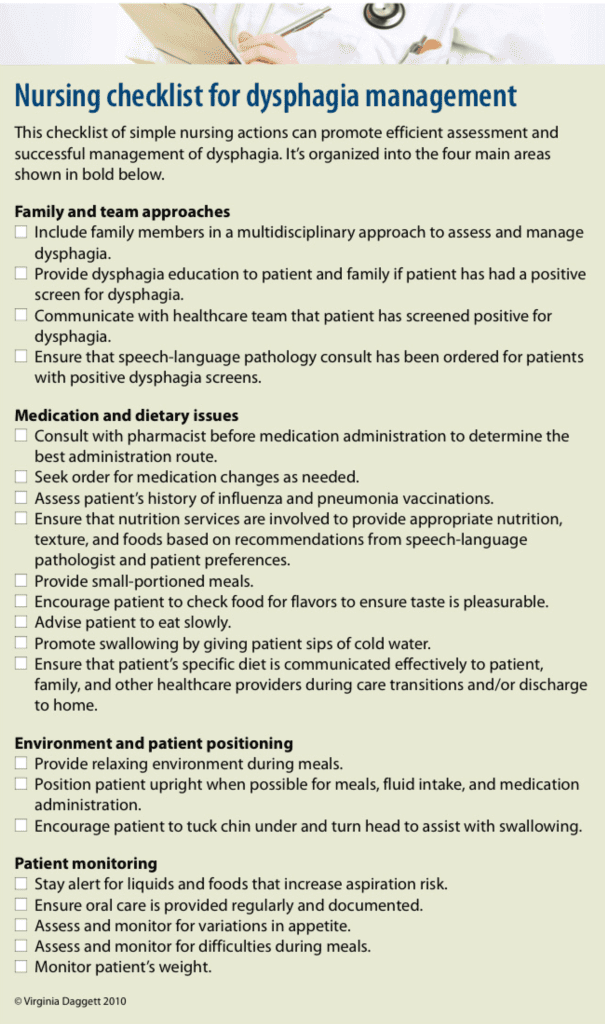The risk of developing dysphagia (difficulty swallowing) increases with age and exposure to aging-related diseases and conditions. Roughly 7% to 10% of adults older than age 50 have been diagnosed with dysphagia; an estimated 14% of adults older than age 60 have dysphagia or another type of swallowing disorder. Dysphagia strikes about 15% of persons in community settings and nearly 40% of long-term-care patients.
Dysphagia results from the normal physiologic changes of aging, including declines in sensory functioning, skeletal muscle strength, and reflexes; increased connective tissue; and delayed pharyngeal swallowing. Some experts believe certain drugs commonly used by elderly patients contribute to dysphagia development. For example, tricyclic antidepressants, anti-inflammatory drugs, and diuretics may increase dry mouth and impair elderly patients’ ability to swallow. Also, some progressive neurologic conditions, such as Alzheimer’s and Parkinson’s diseases, increase an older adult’s dysphagia risk, as do traumatic brain injury; surgery; tumors of the head, neck, and throat; and, most notably, stroke. In stroke patients, dysphagia prevalence ranges from 25% to 70%. Elderly hospital patients are at increased risk for both dysphagia and aspiration pneumonia.
If you care for elderly patients, you need to be aware of the factors that may make them more vulnerable to dysphagia, as well as the challenges of caring for dysphagic patients, simple techniques to improve nursing skills with these patients, and multidisciplinary approaches to management. This article describes factors related to dysphagia in the elderly, reviews management challenges, describes multidisciplinary team approaches to managing dysphagia in acute-care settings, and presents a nursing skills checklist for inpatient management.
Challenges in assessment and management
The literature hasn’t consistently identified a hallmark dysphagia screening tool for nurses. Unfortunately, ineffective dysphagia assessment and management may lead to poor patient outcomes, such as aspiration pneumonia, malnutrition, dehydration, reduced quality of life, and even death. What’s more, conflicting dysphagia screening and management guidelines may exist for specific patient populations—
a particular challenge for healthcare professionals and organizations.
Elderly patients may have reduced saliva production from oral or dental disease or medication side effects. This may lead to poor oral care and colonies of pathogenic organisms in the oropharynx. Because dysphagia may compromise the patient’s nutritional status, alternative intake methods may be required. However, controversy surrounds such methods, including questions about accuracy in administration of thickening agents and decreased quality of life in patients receiving tube feedings.
Further complicating dysphagia management in the elderly is the need to administer drugs in alternative forms. Crushing medications or opening capsules before administration may have pharmacologic and legal implications. For instance, initial overdoses may occur when a controlled- or sustained-release drug is crushed, causing it to be absorbed in minutes instead of the recommended 12 to 24 hours. These common practices may contradict the drug product license that describes proper conditions for administration—which increases the nurse’s liability.
Ethical issues
Ethical issues may arise when dysphagic patients have cognitive or communicative impairments. Although caregivers should strive to maintain patient autonomy, the patient’s decision-making capacity must be evaluated. Family members may need to be consulted to determine the patient’s treatment preference.
Ethical dilemmas also may emerge over organizational, state, and national dysphagia management guidelines; decisions on whether to decline alternative nutrition and hydration methods; obtaining proper informed consent; and the role of the nurse and other healthcare team members in consent and decision-making processes.
Multidisciplinary approaches
As the elderly population with dysphagia increases, national and international healthcare organizations have undertaken initiatives to address the diverse challenges of dysphagia management. A 2005 interventional study examined healthcare providers’ compliance with swallowing recommendations in dysphagic patients at an acute-care setting in London. Both before and after intervention, researchers observed providers’ compliance regarding fluid consistency, dietary modifications, portion sizes of liquids and foods at meals, swallowing strategies, adherence to safe swallowing guidelines, and required supervision. Simple, low-cost changes in dysphagia practices were then implemented, leading to significant changes in postintervention compliance. These simple changes included:
- developing a dysphagia compliance group accountable for instituting procedures to improve dysphagia care, including a consultant on older adults’ medications
- establishing a quarterly 2-hour training program requiring nurses to meet specific criteria when caring for dysphagic patients
- escalating an existing three-tiered dysphagia training program for qualified nurses, healthcare assistants, and catering staff
- making prethickened drinks accessible in all patient units
- redesigning swallow-advice sheets posted at dysphagic patients’ beds.
A 2008 collaborative project focused on safe medication swallowing in dysphagic patients in a 500-bed long-term-care facility. Using process redesign methods, it addressed inadequate communication of important information for safe medication administration in these patients. The collaborative resulted in:
- implementation of consistent terminology in speech-language pathology recommendations
- integration of speech-language pathology recommendations into physician orders and the medication administration record
- development of a dysphagia alert on the pharmacy’s computer system.
VA collaborative project
A recent collaborative project at a Veterans Affairs (VA) Medical Center addressed conflicting dysphagia guidelines for veterans who’d been admitted for care, an ineffective dysphagia screening tool, and educational needs. Although the Veterans Healthcare Administration stipulated that all veterans admitted to VA medical centers be screened for dysphagia within 24 hours of admission, the guideline wasn’t consistent with the Joint Commission guideline for acute stroke patients, which prohibits all oral intake until the patient has been assessed for dysphagia.
Frontline staff from multiple disciplines and units as well as members of the Stroke Quality Enhancement Research Initiative (QUERI) used systems (processes) redesign to address these inconsistencies and additional project objectives. Redesign processes led to adoption of the following practice: All veterans are placed on “nothing-by-mouth” status until the dysphagia screen is performed by the admission nurse within 8 hours of admission.
Frontline staff used the same methodology to revise a dysphagia screening tool to assess veterans for dysphagia, performed usability testing of the revised dysphagia screening tool, and subsequently adopted it into practice. Educational materials were developed to promote patients’ and families’ understanding of dysphagia and potential complications; materials also were developed for nursing staff to enhance their understanding of their role in managing dysphagia.
Skills needed to manage dysphagia
Dysphagia management in elderly patients is complex and involves multiple disciplines. To provide optimal dysphagia screening and management, nurses caring for elderly patients need to thoroughly understand organizational and national guidelines applicable to this patient population. These guidelines may differ across diseases and conditions.
Based on a literature review, this author developed a dysphagia management nursing checklist that incorporates tips for practice and professional experience in addressing dysphagia management challenges. (See Nursing checklist for dysphagia management.)
Managing dysphagia in the elderly cuts across many dimensions of care. Understanding the unique challenges involved and mastering simple bedside skills can decrease complications. Using simple tools and systems redesign processes, nurses can successfully lead performance-improvement projects tailored to their organization’s needs to improve dysphagia management in the elderly.
Selected references
American Speech-Language-Hearing Association. Communication facts: special populations: dysphagia—2008 edition. www.asha.org/research/reports/dysphagia.htm. Accessed January 6, 2011.
Humbert IA, Robbins J. Dysphagia in the elderly. Phys Med Rehabil Clin N Am. 2008;19:853-866.
Identification and nursing management of dysphagia in adults with neurological impairment. The Joanna Briggs Institute. Best Practice: Evidence Based Practice Information Sheets for Health Professionals. 2000;4(2). http://onlinelibrary.wiley.com/doi/10.1111/j.1744-1609.2011.00211.x/abstract. Accessed January 6, 2011.
Jackson LD, Little J, Kung E, Williams EM, Siemiatkowska K, Plowman S. Safe medication swallowing in dysphagia: a collaborative improvement project. Healthc Q. 2008;11(3 Spec No.):110-116.
Joint Commission. Disease-Specific Care Certification Program: Stroke Performance Measurement Implementation Guide. 2nd ed., Version 2.A; Updated October 2008. http://www.jointcommission.org/assets/1/18/stroke_pm_implementation_guide_ver_2a.pdf. Accessed January 5, 2011.
Kikawada M, Iwamato T, Takasaki M. Aspiration and infection in the elderly. Drugs Aging. 2005;22(2):115-130.
Morris H. Dysphagia in the elderly: a management challenge for nurses. Brit J Nurs. 2006;15(10):558-562.
Rosenvinge SK, Starke ID. Improving care for patients with dysphagia. Age Ageing. 2005;34:587-593.
Sharp HM. Ethical issues in the management of dysphagia after stroke. Top Stroke Rehabil. 2006;13(4):18-25.
Veterans Health Administration, Department of Veterans Affairs: VHA directive for management of patients with swallowing (dysphagia) or feeding disorders. Washington, DC: Department of Veterans Affairs; 2006. http://www1.va.gov/vhapublications/ViewPublication.asp?pub
_ID=1422. Accessed January 6, 2011.
Virginia S. Daggett is Co-Implementation Research Coordinator for the National Veterans Administration/Health Services, Research & Development Stroke QUERI at Richard L. Roudebush VA Medical Center in Indianapolis, Indiana. She is also an adjunct professor at Indiana University School of Nursing in Indianapolis.



















